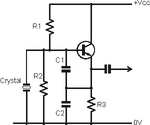cosmo19
Newbie level 3
Considering the following circuit, which I couldn't upload from my mobile, but its identical to this one here + a tank circuit between the collector and the VCC.
**broken link removed**
I am confused and can't understand how the tank circuit, which is open at resonance, and the transistor pass the 2nd or any other harmonic of a crystal of a fundamental frequency of, say, 48 MHz.
What frequency is at the output if the tank is open at resonance 48MHz for example?
1. How does the tank circuit contribute to or govern the choice of the desired Harmonic at the output if a parallel LC is "open circuit" at resonance?
2. How can I calculate L1 and C4 to have the desired frequency at the output?
Do I have to include the transistors' output capacitance in calculating the tank circuit? What is formula for that?
Many thanks in advance!
**broken link removed**
I am confused and can't understand how the tank circuit, which is open at resonance, and the transistor pass the 2nd or any other harmonic of a crystal of a fundamental frequency of, say, 48 MHz.
What frequency is at the output if the tank is open at resonance 48MHz for example?
1. How does the tank circuit contribute to or govern the choice of the desired Harmonic at the output if a parallel LC is "open circuit" at resonance?
2. How can I calculate L1 and C4 to have the desired frequency at the output?
Do I have to include the transistors' output capacitance in calculating the tank circuit? What is formula for that?
Many thanks in advance!
